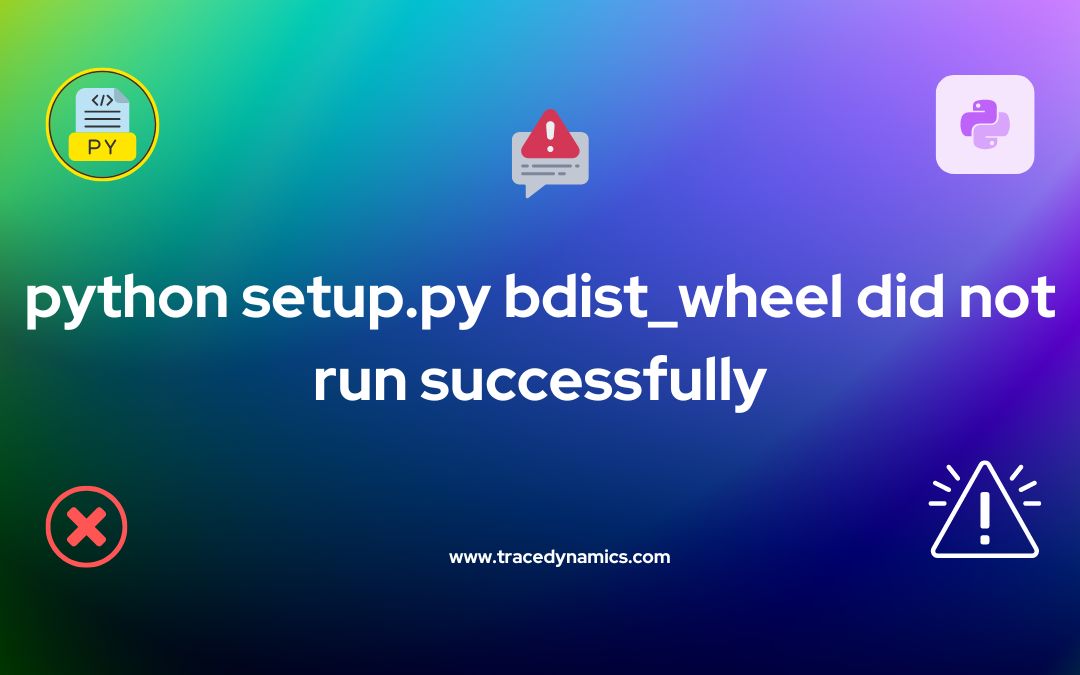Ah, the dreaded error message: “python setup.py bdist_wheel did not run successfully”. It’s enough to send shivers down the spine of any Python developer. Fear not, fellow programmer, for I am here to guide you through the murky depths of this error and help you emerge victorious!
Unraveling the Mystery: Why Your Wheel Won’t Spin
Before we delve into solutions, let’s understand the cause of this error. When you run python setup.py bdist_wheel, Python attempts to build a wheel, a platform-specific compressed archive containing your Python package and its dependencies. However, this process can encounter various obstacles, leading to the dreaded error message.
Here are some common culprits:
- Missing dependencies: Your package might require specific libraries not installed on your system.
- Incompatible dependencies: Conflicting versions of dependencies can cause build failures.
- Platform-specific issues: Certain libraries might not be compatible with your operating system or Python version.
- Errors in your setup.py script: Typos, syntax errors, or incorrect configurations can derail the wheel build process.
Diagnosing the Problem: Identifying the Root Cause
To effectively address the error, we need to pinpoint its exact cause. Here are some steps to diagnose the issue:
- Review the build output: Carefully examine the output generated when running python setup.py bdist_wheel. Look for specific error messages that might indicate the source of the problem.
- Check your dependencies: Ensure all your package dependencies are installed and compatible with your Python version. Use tools like pip list and pip show to verify their versions.
- Analyze your setup.py script: Double-check your setup script for any typos, syntax errors, or incorrect configurations. Look for missing dependencies, improper version specifications, or incompatible platform settings.
- Seek online resources: Search online forums, documentation, and Stack Overflow for similar error messages and solutions. Sharing your specific error message along with your setup script can yield valuable insights.
Building the Wheel: Strategies for Success
Once you have identified the cause of the error, you can implement the appropriate solution. Here are some strategies to overcome the “bdist_wheel” woes:
- Install missing dependencies: Use pip install to install all missing dependencies required by your package. Ensure you install the correct versions compatible with your Python environment.
- Resolve conflicting dependencies: If conflicting versions of dependencies are causing issues, consider using virtual environments to isolate different versions for different projects. Alternatively, update or downgrade specific dependencies to ensure compatibility.
- Address platform-specific issues: If you encounter platform-specific issues, consult the documentation of the problematic library. Look for platform-specific installation instructions or alternative libraries that work on your system.
- Fix setup.py errors: Meticulously review your setup script and fix any identified typos, syntax errors, or configurations. Ensure all dependencies are properly listed, version specifications are accurate, and platform settings are correct.
- Seek help from the community: If you’re still struggling, don’t hesitate to reach out to the Python community. Post your issue on forums, Stack Overflow, or dedicated mailing lists. Sharing your problem details and setup script will likely connect you with someone who has faced and conquered a similar challenge.
Beyond the Wheel: Tips for Smooth Sailing
By implementing these strategies, you can overcome the “bdist_wheel” error and build your Python packages successfully. But to truly master the wheel, remember these tips for smooth sailing:
- Maintain a clean and well-organized setup.py script.
- Document your dependencies clearly.
- Test your packages thoroughly on different platforms.
- Stay updated with the latest Python versions and libraries.
- Build virtual environments for different projects to avoid dependency conflicts.
By adhering to these best practices, you can ensure a smooth and efficient Python development experience, leaving the dreaded “bdist_wheel” error far behind. So, roll up your sleeves, embrace the challenge, and conquer the Python wheel!
Frequently Asked Questions (FAQs)
What does 'python setup.py bdist_wheel did not run successfully' mean?
This error indicates that Python encountered a problem while attempting to build a wheel package, often due to missing dependencies, syntax errors in setup.py, or compatibility issues.
How can I diagnose the cause of this error?
To diagnose, review the build output for specific error messages, check your package dependencies, and ensure your setup.py script is free from errors.
What are common causes of this error?
Common causes include missing or incompatible dependencies, platform-specific issues, or errors in the setup.py script.
How can I fix missing dependency issues?
Install any missing dependencies using pip install and ensure they are compatible with your Python environment.
What should I do if I have conflicting dependencies?
Resolve conflicting dependencies by creating virtual environments or updating/downgrading specific dependencies.
Can platform-specific issues cause this error?
Yes, platform-specific compatibility issues with libraries can cause this error. Consult the library documentation for platform-specific instructions.
How can I correct errors in my setup.py script?
Carefully review your setup.py script for syntax errors, typos, or incorrect configurations and correct them.
Is there a way to seek help for this error online?
Yes, you can search online forums, Stack Overflow, or Python community resources for similar issues and solutions.
Are there any best practices to avoid this error in the future?
Maintain a clean setup.py, document dependencies clearly, test on different platforms, and stay updated with Python versions and libraries.
What role do virtual environments play in resolving this error?
Virtual environments can isolate dependencies for different projects, helping to manage conflicting versions and avoid such errors.

